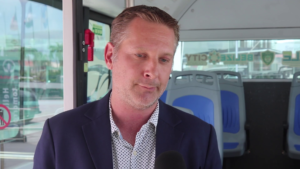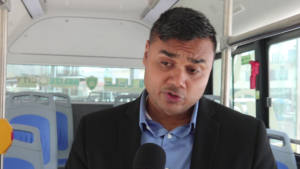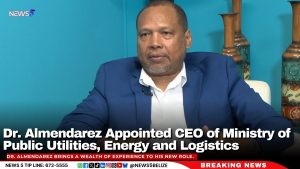Training Held for Technical Staff of Belize City’s e-Buses
It’s been more than three months since the first e-bus arrived as part of Belize City’s gradual shift from fuel-operated to electric buses for public transportation. The Belize City Council says there’s been a lot of work done over that time to make the transition seamless. Part of that transition is getting the technical personnel who will be responsible for driving, repairing and maintaining the e-buses familiar with the vehicle. So this week, those persons are in training, held by Build Your Dream, the company that manufactured the e-buses. A delegation of from BYD is in Belize to conduct the training with drivers, conductors, and personnel from the Department of Transport. News Five’s Marion Ali went on board one of the buses today and filed this report.
Marion Ali, Reporting
At first glance, it looks like any other bus, but this e-bus has features that we, in Belize, aren’t necessarily accustomed to. Before we get into the cool aspects of what the bus can do, the city’s e- Transit Start-up Coordinator, Neil Hall says it’s not just drivers, conductors and technical staff who are receiving the training.

Neil Hal
Neil Hall, e-Transit Start-up Coordinator, Belize City Council
“They’ll be training on first responders. So when the police or the EMTs need to access the vehicle for any particular reason, they’ll know the proper way of doing it, so it’s safe for everyone. On Monday, we’ll start doing other types of trainings that are more physical training. At that point, we’ll have the buses actually start hitting the streets and do range testing, heat testing, speed testing, capacity testing and several different types of tests, physical tests for the buses themselves.”
Chad Dietrich is the General Manager for Caribbean Motors, which is participating in the training sessions.

Chad Dietrich
Chad Dietrich, General Manager for Caribbean Motors
“Some of these features that we’re explaining, yeah, they’re new to us in a lot of cases because of the newer versions of the bus that this is. But as for the difference between diesel and electric, in some cases it’s how do you tow it? Because of the different mechanical systems. How do we maintain it? There’s actually a lot less maintenance required for an electric bus. But it’s making sure that our mechanics and those that are maintaining these buses know exactly the procedures how to do that. Just, it’s a big investment, so we want to keep them in tip top shape so they last a long time.”
Dr. Curtis Boodoo is the UNDP’s e-mobility expert in Belize. The UNDP is the implementing agency for the pilot project, which is funded by the European Union.

Dr. Curtis Boodoo
Dr. Curtis Boodoo, UNDP’s e-Mobility Expert
“It is our hope, but I am very confident that this will transform the transportation sector in Belize. The inclusion of these two buses, and we have three other buses to come as well as part of the project. Belize uses around 40 percent of your national energy for transport. So that is gasoline, diesel, et cetera, that you import. Having electric vehicles, and in this case, an electric bus, ensures that you more efficiently use your fuel that you import. Electric vehicles, electric buses, around three times more efficient than a normal bus, diesel, or normal car. So you make more efficient use of it. There is a push towards the increasing the use of solar in Belize. The more renewable energy you generate in Belize, the less fossil fuels you burn. So the cleaner the energy becomes.”
And about those cool features I mentioned, Dietrich gives us a first look at those.
 Chad Dietrich
Chad Dietrich
“This is a low floor city bus, so it sits low. Number one, it also kneels. So that means it tilts down to the curb level to make it easy for people to get on one one people group that makes it a lot easier for is those that are mobility challenge. So we have a wheelchair ramp here so I can quickly flip that out for you. We have a wheelchair ramp. We also have a call button on the outside of the bus. So if there’s somebody that needs the ramp flipped out. There’s a call button that alerts the driver, and then somebody will get out and assist. So there is a way for us to affix the wheelchair here in the bus, and also when they want to get off, there’s a special button that they’ll press to alert the driver and the conductor so they can be assisted. For those wanting to get off at a certain stop, certainly the stops will be listed up on the screen at the front. I also see time and temperature up there. And then these stop buttons will also alert the driver that somebody wants to be wants to get off at a particular stop.”
 The buses are air-conditioned and have USB phone chargers near the seats and free Wi Fi for passengers. But these e-buses, like many of those internationally, accommodates more standees than sitting passengers, with only twenty-three seats, and room for twenty-seven standees with rails to hold onto. Meanwhile, Neil Hall says the launch of the new e-buses is scheduled for July. The plan, he says, is to fully replace all of Belize City’s fuel-operated buses with e-buses at affordable prices. Marion Ali for News Five.
The buses are air-conditioned and have USB phone chargers near the seats and free Wi Fi for passengers. But these e-buses, like many of those internationally, accommodates more standees than sitting passengers, with only twenty-three seats, and room for twenty-seven standees with rails to hold onto. Meanwhile, Neil Hall says the launch of the new e-buses is scheduled for July. The plan, he says, is to fully replace all of Belize City’s fuel-operated buses with e-buses at affordable prices. Marion Ali for News Five.







Facebook Comments